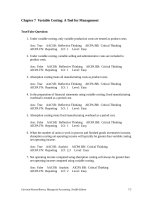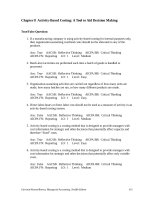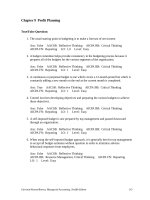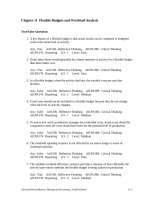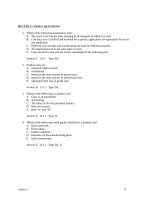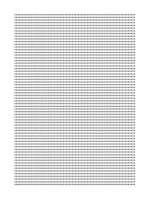Test bank managerial accounting by hilton 9e chapter18
Bạn đang xem bản rút gọn của tài liệu. Xem và tải ngay bản đầy đủ của tài liệu tại đây (166.62 KB, 36 trang )
MULTIPLE CHOICE QUESTIONS
1. Which of the following would be considered a service department for an airline?
A. Maintenance.
B. Information Systems.
C. Purchasing.
D. Flight Catering.
E. All of the above.
Answer: E LO: 1 Type: N
2. Which of the following would not be considered a service department in a hospital?
A. Security.
B. Cardiac Care.
C. Patient Records.
D. Accounting.
E. Human Resources.
Answer: B LO: 1 Type: RC
3. Consider the following statements about service department costs:
I.The costs of the Human Resources Department in a manufacturing organization must be
allocated to production departments in order to achieve a correct costing of inventory.
II.The allocation of service department costs requires that an organization select both an
allocation base and an allocation method.
III.Service department cost allocations are more relevant for firms involved in service
industries (e.g., repair, health care) than for those involved with manufacturing.
Which of the above statements is (are) correct?
A. I only.
B. II only.
C. I and II.
D. II and III.
E. I, II, and III.
Answer: C LO: 1 Type: RC, N
4. Which of the following methods ignores the fact that some service departments provide
service to other service departments?
A. Direct method.
B. Indirect method.
C. Step-down method.
D. Reciprocal method.
E. Dual-cost allocation method.
Answer: A LO: 1 Type: RC
44
Hilton, Managerial Accounting, Seventh Edition
5. Consider the following statements about the direct method of service department cost
allocation:
I.Under the direct method, all service department costs are eventually allocated to production
departments.
II.The order in which service department costs are allocated to production departments is
important.
III.Once a service department's costs have been allocated, no costs are re-circulated back to
that department.
Which of the above statements is (are) correct?
A. I only.
B. II only.
C. I and II.
D. I and III.
E. I, II, and III.
Answer: D LO: 1 Type: RC
6. The Milrose Clinic has two service departments (Human Resources and Information
Resources) and two "production" departments (In-patient Treatment and Out-patient
Treatment). The service departments service each other, and studies have shown that
Information Resources provides the greater amount of service. Which of the following
allocations would occur if Milrose uses the direct method of cost allocation?
A. Information Resources cost would be allocated to In-patient Treatment.
B. Information Resources cost would be allocated to Human Resources.
C. Human Resources cost would be allocated to Information Resources.
D. In-patient Treatment cost would be allocated to Out-patient Treatment.
E. Out-patient Treatment cost would be allocated to Information Resources.
Answer: A LO: 1 Type: N
7. Trackster Corporation has two service departments (Maintenance and Human Resources) and
three production departments (Machining, Assembly, and Finishing). Maintenance is the
largest service department and Assembly is the largest production department. The two
service departments service each other as well as the three producing departments. On the
basis of this information, which of the following cost allocations would not occur under the
direct method?
A. Machining cost would be allocated to Assembly.
B. Maintenance cost would be allocated to Finishing.
C. Maintenance cost would be allocated to Human Resources.
D. Human Resources cost would be allocated to Finishing.
E. Allocations "A" and "C" would not occur.
Answer: E LO: 1 Type: N
45
Hilton, Managerial Accounting, Seventh Edition
8. Which of the following methods recognizes some (but not all) of the services that occur
between service departments?
A. Direct method.
B. Step-down method.
C. Indirect method.
D. Reciprocal method.
E. Dual-cost allocation method.
Answer: B LO: 1 Type: RC
9. When the step-down method is used, the service department whose costs are allocated first is
often the department that:
A. obtains the highest yield.
B. has the lowest cost.
C. is the newest.
D. serves the greatest number of other service departments.
E. serves the fewest other service departments.
Answer: D LO: 1 Type: RC
10. Consider the following statements about the step-down method of service department cost
allocation:
I.Under the step-down method, all service department costs are eventually allocated to
production departments.
II.The order in which service department costs are allocated is important.
III.Once a service department's costs have been allocated, no costs are re-circulated back to
that department.
Which of the above statements is (are) correct?
A. I only.
B. II only.
C. I and II.
D. I and III.
E. I, II, and III.
Answer: E LO: 1 Type: RC
Chapter 18
46
11. Duluth Corporation has two service departments (Maintenance and Human Resources) and
three production departments (Machining, Assembly, and Finishing). The two service
departments service each other, and studies have shown that Maintenance provides the
greatest amount of service. On the basis of this information, which of the following cost
allocations would likely occur under the step-down method?
A. Machining cost would be allocated to Assembly.
B. Maintenance cost would be allocated to Finishing.
C. Maintenance cost would be allocated to Human Resources.
D. Human Resources cost would be allocated to Maintenance.
E. Allocations "B" and "C" above.
Answer: E LO: 1 Type: N
12. The Hopwood Clinic has two service departments (Human Resources and Information
Systems) and two "production" departments (In-patient Treatment and Out-patient Treatment).
The service departments service each other, and studies have shown that Information Systems
provides the greatest amount of service. Which of the following allocations would not occur if
Hopwood uses the step-down method of cost allocation?
A. Information Systems cost would be allocated to Human Resources.
B. Human Resources cost would be allocated to Information Systems.
C. Human Resources cost would be allocated to In-patient Treatment.
D. In-patient Treatment cost would be allocated to Out-patient Treatment.
E. Allocations "B" and "D" above.
Answer: E LO: 1 Type: N
13. Which of the following methods accounts for 100% of the services that occur between service
departments?
A. Direct method.
B. Indirect method.
C. Reciprocal method.
D. Step-down method.
E. Dual-cost allocation method.
Answer: C LO: 1, 6 Type: RC
14. Reno Corporation has two service departments (Maintenance and Human
Resources) and three production departments (Machining, Assembly, and
Finishing). The two service departments service each other, and studies
have shown that Maintenance provides the greatest amount of service.
Given the various cost allocation methods, which of the following choices
correctly denotes whether Maintenance cost would be allocated to Human
Resources?
Direct
Step-Down
Reciprocal
A.
Yes
No
Yes
B.
Yes
No
No
C.
Yes
Yes
Yes
D.
No
Yes
No
47
Hilton, Managerial Accounting, Seventh Edition
E.
No
Yes
Yes
Answer: E LO: 1, 6 Type: N
Chapter 18
48
15. Which of the following methods would be of little use when allocating service department
costs to production departments?
A. The direct method.
B. The reciprocal method.
C. The step-down method.
D. The net-realizable-value method.
E. The dual-cost allocation method.
Answer: D LO: 1, 2, 4 Type: N
16. Ryan, Inc., has two service departments (Human Resources and Building Maintenance) and
two production departments (Machining and Assembly). The company allocates Building
Maintenance cost on the basis of square footage and believes that Building Maintenance
provides more service than Human Resources. The square footage occupied by each
department follows.
Human Resources
Building Maintenance
Machining
Assembly
4,000
11,000
16,000
22,000
Assuming use of the direct method, over how many square feet would the Building
Maintenance cost be allocated (i.e., spread)?
A. 15,000.
B. 38,000.
C. 42,000.
D. 53,000.
E. More information is needed to judge.
Answer: B LO: 1 Type: A
49
Hilton, Managerial Accounting, Seventh Edition
17. Peterson Company has two service departments (Cafeteria and Human Resources) and two
production departments (Machining and Assembly). The number of employees in each
department follows.
Cafeteria
Human Resources
Machining
Assembly
40
60
200
300
Peterson uses the direct method of cost allocation and allocates cost on the basis of employees.
If Human Resources cost amounts to $1,800,000, how much of the department's cost would be
allocated to Machining?
A. $600,000.
B. $720,000.
C. $900,000.
D. $1,200,000.
E. Some other amount.
Answer: B LO: 1 Type: A
18. Durango, Inc., has two service departments (Human Resources and Building Maintenance)
and two production departments (Machining and Assembly). The company allocates Building
Maintenance cost on the basis of square footage and believes that Building Maintenance
provides more service than Human Resources. The square footage occupied by each
department follows.
Human Resources
Building Maintenance
Machining
Assembly
5,000
9,000
15,000
22,000
Assuming use of the step-down method, over how many square feet would the Building
Maintenance cost be allocated (i.e., spread)?
A. 14,000.
B. 37,000.
C. 42,000.
D. 51,000.
E. More information is needed to judge.
Answer: C LO: 1 Type: A
Chapter 18
50
19. Anniston, Inc., has two service departments (Human Resources and Building Maintenance) and
two production departments (Machining and Assembly). The company allocates Building
Maintenance cost on the basis of square footage and Human Resources cost on the basis of
employees, and believes that Building Maintenance provides more service than Human
Resources. The square footage and employees in each department follow.
Human Resources
Building Maintenance
Machining
Assembly
Square
Footage
4,000
10,000
15,000
21,000
Employees
10
15
40
60
Assuming use of the step-down method, which of the following choices
correctly denotes the number of square feet and employees over which the
Building Maintenance cost and Human Resources cost would be allocated
(i.e., spread)?
Building
Human
Maintenance
Resources
A. 36,000
100
B. 40,000
100
C. 46,000
110
D. 50,000
110
E. Some other combination of figures not listed above.
Answer: B LO: 1 Type: A
20. Western, Inc., has two service departments (Human Resources and Building Maintenance) and
two production departments (Machining and Assembly). The company allocates Building
Maintenance cost on the basis of square footage and believes that Building Maintenance
provides more service than Human Resources. The square footage occupied by each
department follows.
Human Resources
Building Maintenance
Machining
Assembly
3,500
8,700
9,900
15,000
Over how many square feet would the Building Maintenance cost be
allocated (i.e., spread) with the direct method and the step-down method?
Direct
Step-Down
Method
Method
A. 24,900
28,400
B. 24,900
37,100
C. 28,400
24,900
D. 37,100
24,900
E. Some other combination of figures not listed above.
Answer: A LO: 1 Type: A
51
Hilton, Managerial Accounting, Seventh Edition
21. Saunders Company has two service departments (Cafeteria and Human Resources) and two
production departments (Machining and Assembly). The number of employees in each
department follows.
Cafeteria
Human Resources
Machining
Assembly
20
30
100
150
Saunders uses the step-down method of cost allocation and allocates cost on the basis of
employees. Human Resources cost amounts to $1,200,000, and the department provides more
service to the firm than Cafeteria. How much Human Resources cost would be allocated to
Machining?
A. $0.
B. $428,572.
C. $444,444.
D. $480,000.
E. Some other amount.
Answer: C LO: 1 Type: A
22. Hunt Corporation has two service departments (S1 and S2) and two production departments
(P1 and P2), and uses the step-down method of cost allocation. Management has determined
that S1 provides more service to the firm than S2, and has decided that the number of
employees is the best allocation base to use for S1. The following data are available:
Department
S1
S2
P1
P2
Number of
Employees
10
20
50
70
Which of the following statements is (are) true if S1 and S2 have respective operating costs of
$280,000 and $350,000?
A. S2 should allocate a portion of its $350,000 cost to S1.
B. S1's cost should be allocated (i.e., spread) over 140 employees.
C. S1's cost should be allocated (i.e., spread) over 150 employees.
D. S2 should allocate a total of $390,000 to P1 and P2.
E. Statements "B" and "D" are both correct.
Answer: E LO: 1 Type: A
Chapter 18
52
Use the following to answer questions 23-25:
The Dollar Store has a Human Resources Department and a Janitorial Department that provide service
to three sales departments. The Human Resources Department cost is allocated on the basis of
employees, and the Janitorial Department cost is allocated on the basis of space. The following
information is available:
Budgeted cost
Space in square feet
Number of employees
Human
Resources
$45,000
4,000
5
Janitorial
$30,000
1,000
10
Sales #1
Sales #2
Sales #3
20,000
15
30,000
45
50,000
30
23. Using the direct method, the amount of Janitorial Department cost allocated to Sales
Department no. 2 is:
A. $8,571.
B. $8,654.
C. $9,000.
D. $10,350.
E. $14,210.
Answer: C LO: 1 Type: A
24. Using the step-down method and assuming that Human Resources is allocated first, the
amount of Human Resources cost allocated to Sales Department no. 3 is:
A. $12,000.
B. $12,857.
C. $13,500.
D. $15,000.
E. $22,500.
Answer: C LO: 1 Type: A
25. Using the step-down method and assuming Human Resources is allocated first, the amount of
Janitorial cost allocated to Sales Department no. 2 is:
A. $8,571.
B. $9,000.
C. $9,857.
D. $10,247.
E. $10,350.
Answer: E LO: 1 Type: A
53
Hilton, Managerial Accounting, Seventh Edition
Use the following to answer questions 26-28:
The Dexter Manufacturing Company has two production departments (Assembly and Finishing) and
two service departments (Human Resources and Janitorial). The projected usage of the two service
departments is as follows:
Human Resources
Janitorial
Assembly
Finishing
Use of
Human Resources
--10%
60%
30%
Use of
Janitorial
5%
--40%
55%
The budgeted costs in the service departments are: Human Resources, $90,000 and Janitorial, $50,000.
26. Using the direct method, the amount of Janitorial Department cost allocated to the Finishing
Department is:
A. $21,053.
B. $24,843.
C. $25,000.
D. $28,947.
E. $34,157.
Answer: D LO: 1 Type: A
27. Using the step-down method and assuming the Human Resources Department is allocated
first, the amount of Human Resources cost allocated to the Assembly Department is:
A. $21,053.
B. $28,947.
C. $54,000.
D. $60,000.
E. $78,842.
Answer: C LO: 1 Type: A
28. Using the step-down method and assuming the Human Resources Department is allocated
first, the total amount of service department cost allocated to the Finishing Department is:
A. $58,947.
B. $61,158.
C. $74,000.
D. $78,842.
E. $81,053.
Answer: B LO: 1 Type: A
Chapter 18
54
29. The process of allocating fixed and variable costs separately is called:
A. the separate allocation procedure (SAP).
B. diverse allocation.
C. reciprocal-cost allocation.
D. common-cost allocation.
E. dual-cost allocation.
Answer: E LO: 2 Type: RC
30. Under dual-cost allocation, fixed costs are allocated on the basis of a user department's:
A. long-run usage of a service department's output.
B. short-run usage of a service department's output.
C. long-run usage and short-run usage of a service department's output.
D. neither long-run usage nor short-run usage of a service department's output.
E. either long-run usage or short-run usage of a service department's output.
Answer: A LO: 2 Type: RC
31. Consider the following statements about dual-cost allocation:
I.Dual-cost allocation prevents a change in the short-run activity of one department from
affecting the cost allocated to another department.
II.Dual-cost allocations create an incentive for user department managers to understate their
expected long-run service needs.
III.Dual-cost allocations are generally preferred over lump-sum allocations, or those that
combine variable and fixed costs together.
Which of the above statements is (are) true?
A. I only.
B. III only.
C. I and II.
D. II and III.
E. I, II, and III.
Answer: E LO: 2 Type: RC
32. When allocating service department costs, companies should use:
A. actual costs rather than budgeted costs, and separate rates for variable and fixed costs.
B. budgeted costs rather than actual costs, and separate rates for variable and fixed costs.
C. budgeted costs rather than actual costs, and a rate that combines variable and fixed costs.
D. actual costs rather than budgeted costs, and a rate that combines variable and fixed costs.
E. a rate that is based on matrix theory.
Answer: B LO: 2 Type: RC
55
Hilton, Managerial Accounting, Seventh Edition
33. Gannon Corporation allocates administrative costs on the basis of staff hours. Short-run
monthly usage and anticipated long-run monthly usage of staff hours for Operating
Departments 1 and 2 follow.
Short-run usage (hours)
Long-run usage (hours)
Dept. 1
40,000
45,000
Dept. 2
60,000
55,000
Total
100,000
100,000
If Gannon uses dual-cost accounting procedures and variable administrative costs total
$200,000, the amount of variable administrative cost to allocate to Department 1 would be:
A. $80,000.
B. $85,000.
C. $90,000.
D. $100,000.
E. some other amount.
Answer: A LO: 2 Type: A
34. Ronan Corporation allocates administrative costs on the basis of staff hours. Short-run
monthly usage and anticipated long-run monthly usage of staff hours for Operating
Departments 1 and 2 follow.
Short-run usage (hours)
Long-run usage (hours)
Dept. 1
80,000
90,000
Dept. 2
120,000
110,000
Total
200,000
200,000
If Ronan uses dual-cost accounting procedures and fixed administrative costs total $1,000,000,
the amount of fixed administrative cost to allocate to Department 1 would be:
A. $400,000.
B. $450,000.
C. $500,000.
D. $850,000.
E. some other amount.
Answer: B LO: 2 Type: A
Chapter 18
56
35. Nashville Corporation allocates administrative costs on the basis of staff hours. Short-run
monthly usage and anticipated long-run monthly usage of staff hours for Operating
Departments 1 and 2 follow.
Short-run usage (hours)
Long-run usage (hours)
Dept. 1
45,000
48,000
Dept. 2
55,000
52,000
Total
100,000
100,000
Variable and fixed administrative costs total $180,000 and $400,000, respectively. If
Nashville uses dual-cost accounting procedures, the total amount of administrative cost to
allocate to Department 2 would be:
A. $301,600.
B. $307,000.
C. $313,600.
D. $319,000.
E. some other amount.
Answer: B LO: 2 Type: A
36. A company that uses activity-based costing would likely allocate costs from:
A. service departments to production departments.
B. service departments to products and services.
C. service departments to production departments and then to products and services.
D. activity-cost pools to production departments.
E. activity-cost pools to products and services.
Answer: E LO: 3 Type: RC
37. The point in a joint production process where each individual product becomes separately
identifiable is commonly called the:
A. decision point.
B. separation point.
C. individual product point.
D. split-off point.
E. joint product point.
Answer: D LO: 4 Type: RC
38. The joint-cost allocation method that recognizes the revenues at split-off but does not consider
any further processing costs is the:
A. relative-sales-value method.
B. net-realizable-value method.
C. physical-units method.
D. reciprocal-accounting method.
E. gross margin at split-off method.
Answer: A LO: 4 Type: RC
57
Hilton, Managerial Accounting, Seventh Edition
39. Which of the following methods should be selected if a company terminates all processing at
the split-off point and desires to use a cost-allocation approach that considers the "revenueproducing ability" of each product?
A. Gross margin at split-off method.
B. Reciprocal-accounting method.
C. Relative-sales-value method.
D. Physical-units method.
E. Net-realizable-value method.
Answer: C LO: 4 Type: N
40. Which of the following choices correctly denotes the data needed to
allocate joint costs under the relative-sales-value method?
Sales Value
Sales Value of Product
of Product
Separable
After Processing
at Split-Off
Cost
Beyond Split-Off
A.
Yes
Yes
No
B.
Yes
Yes
Yes
C.
Yes
No
No
D.
No
Yes
Yes
E.
No
No
Yes
Answer: C LO: 4 Type: RC
41. When allocating joint costs, Wolstein calculates the final sales value of the various products
manufactured and subtracts appropriate separable costs. The company is using the:
A. gross margin at split-off method.
B. reciprocal-accounting method.
C. relative-sales-value method.
D. physical-units method.
E. net-realizable-value method.
Answer: E LO: 4 Type: RC
42. Webster manufactures A, B, and C, all of which are joint products, and D, which is classified
as a by-product. If joint manufacturing costs amount to $450,000 and the company is using a
popular accounting method, the firm will:
A. allocate $450,000 among A, B, and C.
B. allocate $450,000 among A, B, C, and D.
C. increase $450,000 by the net realizable value of D and then allocate the total among A, B,
and C.
D. decrease $450,000 by the net realizable value of D and then allocate the total among A, B,
and C.
E. decrease $450,000 by the net realizable value of D and then allocate the total among A, B,
C, and D.
Answer: D LO: 4 Type: RC
Chapter 18
58
43. Ithaca Corporation uses the physical-units method to allocate costs among its three joint
products: X, Y, and Z. The following data are available for the period just ended:
Joint processing cost: $800,000
Total production: 150,000 pounds
Share of joint cost allocated to X: $160,000
Share of joint cost allocated to Y: $400,000
Which of the following statements is true?
A. The company would have relied on the sales value of each product when allocating joint
costs to X, Y, and Z.
B. Ithaca produced 30,000 pounds of Z during the period.
C. Ithaca produced 45,000 pounds of Z during the period.
D. Ithaca produced 105,000 pounds of Z during the period.
E. Based on the data presented, it is not possible to determine Ithaca's production of Z during
the period.
Answer: C LO: 4 Type: RC, A
44. Garvin Corporation manufactures joint products P and Q. During a recent period, joint costs
amounted to $80,000 in the production of 20,000 gallons of P and 60,000 gallons of Q.
Garvin can sell P and Q at split-off for $2.20 per gallon and $2.60 per gallon, respectively.
Alternatively, both products can be processed beyond the split-off point, as follows:
Separable processing costs
Sales price (per gallon) if processed beyond split-off
P
$15,000
$3
Q
$35,000
$4
The joint cost allocated to Q under the relative-sales-value method would be:
A. $40,000.
B. $62,400.
C. $64,000.
D. $65,600.
E. some other amount.
Answer: B LO: 4 Type: A
59
Hilton, Managerial Accounting, Seventh Edition
45. Gunniston Corporation manufactures joint products W and X. During a recent period, joint
costs amounted to $300,000 in the production of 20,000 gallons of W and 60,000 gallons of X.
Both products will be processed beyond the split-off point, giving rise to the following data:
Separable processing costs
Sales price (per gallon) if processed beyond split-off
W
$40,000
$14
X
$160,000
$12
The joint cost allocated to W under the net-realizable-value method would be:
A. $75,000.
B. $80,000.
C. $84,000.
D. $90,000.
E. some other amount.
Answer: D LO: 4 Type: A
Use the following to answer questions 46-48:
Rocky Mountain Company produces two products (X and Y) from a joint process. Each product may
be sold at the split-off point or processed further. Additional processing requires no special facilities,
and production costs of further processing are entirely variable and traceable to the products involved.
Joint manufacturing costs for the year were $60,000. Sales values and costs were as follows:
Product
X
Y
Units
Made
9,000
6,000
Sales Value
at Split-off
$40,000
80,000
If Processed Further
Sales
Separable
Value
Costs
$78,000
$10,500
90,000
7,500
46. If the joint production costs are allocated based on the physical-units method, the amount of
joint cost assigned to product X would be:
A. $20,000.
B. $24,000.
C. $30,000.
D. $36,000.
E. $40,000.
Answer: D LO: 4 Type: A
47. If the joint production costs are allocated based on the relative-sales-value method, the amount
of joint cost assigned to product X would be:
A. $20,000.
B. $27,000.
C. $33,000.
D. $40,000.
E. some other amount.
Answer: A LO: 4 Type: A
Chapter 18
60
48. If the joint production costs are allocated based on the net-realizable-value method, the
amount of joint cost assigned to product Y would be:
A. $20,000.
B. $27,000.
C. $33,000.
D. $40,000.
E. some other amount.
Answer: C LO: 4 Type: A
49. Which of the following statements about joint-cost allocation is false?
A. Joint-cost allocation is useful in deciding whether to further process a product after splitoff.
B. Joint-cost allocation is useful in making a profit determination about individual joint
products.
C. Joint-cost allocation is helpful in inventory valuation.
D. Joint-cost allocation can be based on the number of units produced.
E. Joint-cost allocation can be accomplished by using several different methods that focus on
sales value and product "worth."
Answer: A LO: 5 Type: N
50. Consider the following statements about joint product cost allocation:
I.Joint product cost is allocated because it is necessary for inventory valuation.
II.Joint product cost is allocated because it is necessary for making economic decisions about
individual products (e.g., sell at split-off or process further).
III.Joint cost may be allocated to products by using several different methods.
Which of the above statements is (are) correct?
A. I only.
B. III only.
C. I and II.
D. I and III.
E. I, II, and III.
Answer: D LO: 5 Type: RC
51. Eastside Hospital has two service departments (Patient Records and Accounting) and two
"production" departments (Internal Medicine and Surgery). Which of the following
allocations would likely take place under the reciprocal-services method of cost allocation?
A. Allocation of Accounting cost to Patient Records.
B. Allocation of Patient Records cost to Internal Medicine.
C. Allocation of Surgery cost to Accounting.
D. Allocation of Internal Medicine cost to Surgery.
E. Allocations "A" and "B" above.
Answer: E LO: 1 Type: N
61
Hilton, Managerial Accounting, Seventh Edition
52. Westside Hospital has two service departments (Patient Records and Accounting) and two
"production" departments (Internal Medicine and Surgery). Which of the following
allocations would not take place under the reciprocal-services method of cost allocation?
A. Allocation of Accounting cost to Patient Records.
B. Allocation of Patient Records cost to Internal Medicine.
C. Allocation of Surgery cost to Accounting.
D. Allocation of Internal Medicine cost to Surgery.
E. Allocations "C" and "D" above.
Answer: E LO: 1 Type: N
Chapter 18
62
EXERCISES
Fundamentals of Direct and Step-Down Methods
53. Novaturn Corporation has three service departments (S1 and S2) and two production
departments (P1 and P2). S1 and S2 both use the number of employees as an allocation base.
The following data are available:
S1
S2
P1
P2
Number of
Employees
40
60
300
500
Budgeted Cost
$172,000
250,000
660,000
840,000
Required:
A. Assuming use of the direct method:
1.
Over how many employees would S1's budgeted cost be allocated?
2.
How much of S2's cost would be allocated to P1?
3.
How much of P1's cost would be allocated to S1?
B. Assuming use of the step-down method:
1.
How much of S1's cost would be allocated to S2? Novaturn allocates S1's costs
prior to allocating those of S2.
2.
How much of S2's total cost would be allocated to P2?
3.
How much of S2's total cost would be allocated to S1?
LO: 1 Type: A
Answer:
A. 1. 800 (300 + 500)
2. $93,750 [$250,000 x (300/800)]
3. None, because production department costs are not allocated to service departments.
B. 1. S1's costs are allocated over 860 employees (60 + 300 + 500). Thus, $12,000 will be
allocated to S2 [$172,000 x (60/860)].
2. S2's costs total $262,000 ($250,000 + $12,000), resulting in $163,750 being allocated
to P2 [$262,000 x (500/800).
3. None, because S1's costs are allocated prior to those of S2. Once a department is
closed, no costs are allocated back to it.
63
Hilton, Managerial Accounting, Seventh Edition
Direct and Step-Down Methods of Service Department Cost Allocation
54. Wyoming State College has two service departments, the Library and Computing Services,
that assist the School of Business and the School of Health. Budgeted costs of the Library and
Computing Services are $800,000 and $1,800,000, respectively. Usage of the service
departments' output during the year is anticipated to be:
Provider of Service
Computing
Library
Services
--10%
----20%
60%
80%
30%
User of Service
Library
Computing Services
School of Business
School of Health
Required:
A. Use the direct method to allocate the costs of the Library and Computing Services to the
School of Business and the School of Health.
B. Repeat requirement "A" using the step-down method. Wyoming allocates the cost of
Computing Services first.
LO: 1 Type: A
Answer:
A.
Library
Computing Services
Total
B.
$ 800,000
1,800,000
$2,600,000
Computing services ($1,800,000):
Library (10%)
School of Business (60%)
School of Health (30%)
School of Business
Fraction
Amount
2/10
$ 160,000
6/9
1,200,000
$1,360,000
School of Health
Fraction
Amount
8/10
$ 640,000
3/9
600,000
$1,240,000
$ 180,000
1,080,000
540,000
Library ($800,000 + $180,000 = $980,000):
School of Business (20%)
$ 196,000
School of Health (80%)
784,000
Chapter 18
64
Direct and Step-Down Methods of Service Department Cost Allocation
55. Chicago, Inc., manufactures gauges for automobile dashboards. The company has two
production departments, Molding and Assembly. There are three service departments: Human
Resources, Maintenance, and Engineering. Usage of services by the various departments
follows.
Human Resources
Maintenance
Engineering
Molding
Assembly
Human
Resources
-5%
5%
40%
50%
Maintenance
--10%
40%
50%
Engineering
---75%
25%
The budgeted costs in Chicago's service departments are: Human Resources, $180,000;
Maintenance, $270,000; and Engineering, $200,000. The company rounds all calculations to
the nearest dollar.
Required:
A. Use the direct method to allocate Chicago's service department costs to the production
departments.
B. Determine the proper departmental sequence to use in allocating the firm's service costs
by the step-down method.
C. Ignoring your answer in part "B," assume that Human Resources costs are allocated first,
Maintenance costs second, and Engineering costs third. Use the step-down method to
allocate Chicago's service department costs.
LO: 1 Type: A, RC
65
Hilton, Managerial Accounting, Seventh Edition
Answer:
A.
Human Resources
Maintenance
Engineering
Total
$180,000
270,000
200,000
$650,000
Molding
Fraction
Amount
40/90
$ 80,000
40/90
120,000
75/100
150,000
$350,000
Assembly
Fraction
Amount
50/90
$100,000
50/90
150,000
25/100
50,000
$300,000
B.
First: Human Resources (serves two other service departments)
Second: Maintenance (serves one other service department)
Third: Engineering (serves no other service departments)
C.
Human Resources ($180,000):
Maintenance (5%)
Engineering (5%)
Molding (40%)
Assembly (50%)
$ 9,000
9,000
72,000
90,000
Maintenance ($270,000 + $9,000 = $279,000):
Engineering (10%)
Molding (40%)
Assembly (50%)
$ 27,900
111,600
139,500
Engineering ($200,000 + $9,000 + $27,900 = $236,900):
Molding (75%)
Assembly (25%)
$177,675
59,225
Molding: $72,000 + $111,600 + $177,675 = $361,275
Assembly: $90,000 + $139,500 + $59,225 = $288,725
Chapter 18
66
Direct and Step-Down Methods of Service Department Cost Allocation
56. Beckers Corporation is developing departmental overhead rates based on direct labor hours for
its two production departments, Molding and Assembly. The Molding Department worked
20,000 hours during the period just ended, and the Assembly Department worked 40,000
hours. The overhead costs incurred by Molding and Assembly were $151,250 and $440,750,
respectively.
Two service departments, Repair and Power, directly support the two production departments.
These service departments have costs of $90,000 and $250,000, respectively. The following
schedule reflects the use of Repair and Power's output by the various departments:
Repair
Repair (repair hours)
Power (kilowatt hours)
120,000
Power
500
Molding
500
420,000
Assembly
4,000
60,000
Required:
A. Allocate the company's service department costs to production departments by using the
direct method.
B. Calculate the overhead application rates of the production departments. Hint: Consider
both directly traceable and allocated overhead when deriving your answer.
C. Allocate the company's service department costs to production departments by using the
step-down method. Begin with the Power Department, and round calculations to the
nearest dollar.
LO: 1 Type: A
Answer:
A.
Repair
Power
$ 90,000
250,000
$340,000
Molding
Fraction
Amount
0.5/4.5
$ 10,000
4.2/4.8
218,750
$228,750
B.
Allocated service department costs
Overhead costs, traceable to production departments
Total overhead costs
Direct labor hours
Overhead rate per hour
67
Assembly
Fraction
Amount
4.0/4.5
$ 80,000
0.6/4.8
31,250
$111,250
Molding
$228,750
151,250
$380,000
20,000
$19.00
Assembly
$111,250
440,750
$552,000
40,000
$13.80
Hilton, Managerial Accounting, Seventh Edition
C. Power ($250,000):
Repair (120/600)
Molding (420/600)
Assembly (60/600)
Repair ($90,000 + $50,000 = $140,000):
Molding (500/4,500)
Assembly (4,000/4,500)
$ 50,000
175,000
25,000
$ 15,556
124,444
Molding: $175,000 + $15,556 = $190,556
Assembly: $25,000 + $124,444 = $149,444
Understanding Service Department Allocations
57. Consider the following independent cases that relate to service department cost allocations:
Case A: Strickland Company has two service departments [Human Resources (H/R) and
Information Systems] and two production departments (Machining and Assembly). Human
Resource cost is allocated by using the direct method based on the number of personnel in
each department. For the period just ended, there were 189 employees in Machining, and
Machining received $90,000 of H/R's overhead of $200,000. How many employees are in the
Assembly Department?
Case B: Walter Burke, controller of Alexander Enterprises, wants service department
managers to be aware that their use of other service departments costs the firm a substantial
amount of money. Would Burke prefer the direct method or the step-down method of cost
allocation? Why?
Case C: Lockwood Company has four service departments (S1, S2, S3, and S4) and two
production departments (P1 and P2). The costs of S1 are allocated first, followed in order by
the costs of S2, S3, and S4. Lockwood uses the step-down method, and the costs of S2 are
allocated based on the number of computer hours used. Computer hours logged during the
period were as follows: S1, 4,600; S2, 7,100; S3, 10,400; S4, 17,600; P1, 37,000; and P2,
48,600. Over how many hours would S2's cost be allocated?
Case D: A recently hired staff accountant noted that given the nature of the allocations, the
total cost allocated to production departments is typically less under the step-down method
than under the direct method. Do you agree with the accountant? Why?
Required:
Answer the questions that are raised in Cases A, B, C, and D.
LO: 1 Type: A, N
Chapter 18
68



